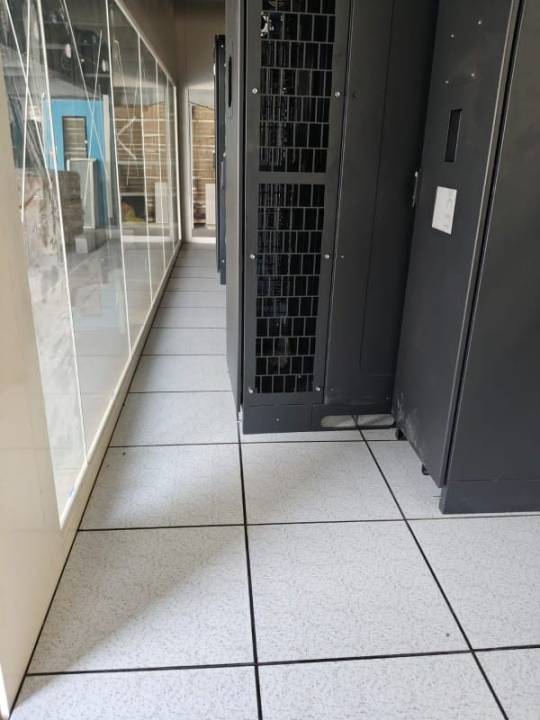Don't wanna be here? Send us removal request.
Text

Bare Panel
0 notes
Text
Why False Flooring is Essential (needed) for Data Centers and IT Infrastructure
Data centers serve as the backbone for any enterprise of substantial size in the advanced digital world today. As enterprises have increased their reliance and dependency on technology, it has therefore become essential for them to ensure the safety, efficiency, and extensibility of their IT infrastructure. One of the most valuable—but often overlooked—items that preserve this ecosystem is false flooring (also referred to as raised access flooring).
What is false flooring?
False flooring is a modular floor system placed on top of the original concrete slab that encloses a plenum or space for necessary services to be run. This space is used to run power cables, data wiring, cooling systems, or any number of devices while having the floor visible and functional.
💡 Reasons Data Centers Require False Floors
1. Effective Cable Management
Data centers have many thousands of servers, switches, and storage systems, and false floors provide you with organized cabling options from power cables and data cables to keep them neat and tidy while eliminating potential trip hazards and the burden of potential maintenance.
2. Improve Cooling and Airflow
A raised access floor is used to distribute cold air from below the raised false floor with airflow panels. It is essential to make cooling as effective as it can be by targeting racks or hot spots to keep areas cool and to reduce equipment failure from overheating.
3. Easy Scalability or Flexibility
Technology changes rapidly, and with this comes changes to cabling infrastructure needs. With a raised floorong you have easy access to cabling and components if you need to upgrade, change, or fix something without statically disturbing service within the facility.
4. Safety and Fire Safety
With everything neatly routed through the floor space, you will not have potential electrical safety hazards. Most raised false floor systems have some type of flame retardant feature to offer higher safety levels in critical facilities.
5. Aesthetics and Organization
Having a clean space free of clutter isn't just about appearances, it's about being able to efficiently work or service equipment when necessary. The raised floor hides unsightly arranging of wiring and HVAC systems to present a more organized and professional looking facility.🧱 Best Panel Types for IT & Data Center Use/best false flooring manufactures for data center.
HPL Panels – Durable, anti-static, and ideal for heavy equipment loads.
Airflow Panels – Perforated tiles for cooling airflow.
Vision Panels – Allow visual inspection of the subfloor without removal.
Bare Panels – Cost-effective for internal or unfinished environments.

📍 Conclusion
False flooring is more than just a technical solution, it is a tactical investment for any data center or IT operation. Whether you're containing heat and cables or quickly reconfiguring the IT infrastructure, raised access floors contribute to efficiency, safety and operational continuity.
In the next few years if your plans are to build a data center or upgrade your IT infrastructure consider that you need a viable false flooring system that meets your needs. For more info visit www.yemag.co.in
2 notes
·
View notes
Text
Raised Flooring vs Traditional Flooring

What is Raised Flooring? Raised flooring (access flooring) is a raised floor system which is fitted above a building's original concrete slab, with a concealed cavity in between the two. This cavity contains electrical wiring, data cabling, HVAC equipment, and plumbing..
Common in:
Data centers
Modern offices
Control rooms
Server rooms
Cleanrooms
Command centers
Raised flooring, also known as access flooring, is an elevated system that creates a hidden cavity between the original concrete floor and the surface panels. This space is incredibly useful for running electrical wires, network cables, air-conditioning ducts, and plumbing. It's particularly favored in data centers, offices, control rooms, and other technology-rich settings where accessibility and cable management are paramount. Raised flooring is convenient to install to upgrade or redesign without excessive civil work. It's easy to maintain – just pop the panel to open what's hidden below.
What is Traditional Flooring? Traditional flooring refers to standard floor finishes like tiles, marble, or hardwood installed directly over the subfloor without any cavity below.
Common in:
Residential homes
Small offices
Retail stores
Apartments and villas
Conversely, traditional flooring is used for standard floor coverings such as tile, wood, or marble laid directly above the subfloor. Although generally applied in residences, retail establishments, and minor offices, traditional flooring does not have the built-in infrastructure room that raised flooring offers. Such that any change to electrical or network systems at a later point can be costly and
Advantages of Raised Flooring
Better Cable Management: Keep your workspace tidy and safe by hiding wires and server connections beneath the floor. Future-Proof & Scalable: Need to install additional workstations or expand your network? Raised flooring allows for changes to be made quickly and inexpensively. Enhanced Cooling & Ventilation: Particularly vital in data centers, where the flow of air is essential to keep equipment. Just lift up a tile to reach your systems — no drilling or hacking required.
Key Differences Raised flooring vs Traditional flooring
Feature
Raised Flooring
Traditional Flooring
Cable Management
Excellent – space for wires, AC, plumbing
Poor – requires wall conduits or surface ducts
Flexibility
High – easy to reconfigure office layouts
Low – major effort to change layout
Maintenance
Easy access to services
Difficult to access concealed wiring
Aesthetics
Clean, modern finish
Depends on surface material
Initial Cost
Slightly higher
Lower upfront
Best For
Tech offices, data centers, commercial buildings
Homes, retail, small offices
Conclusion
Choosing between raised flooring and traditional flooring comes down to purpose, usage, and scalability. For tech-heavy, future-forward environments, raised flooring delivers superior value.
Thinking about upgrading your space with raised access flooring? Contact the experts at YEMAG™ Raised Flooring Pvt. Ltd. (98440-80555 )
1 note
·
View note